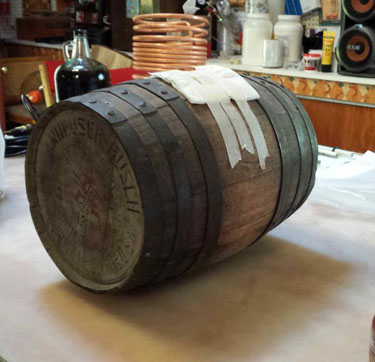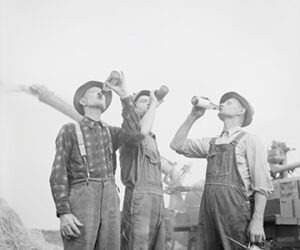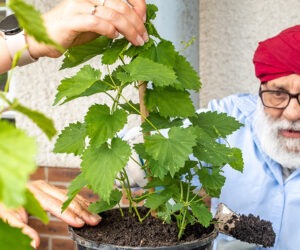Prohibition Porter
Brewing a Prohibition porter usually means using a recipe from the era. What if you had the chance to brew with actual ingredients from that era? I was lucky enough to have that opportunity.
My friend, Paul Wolterbeek, is an avid homebrewer and we often trade ingredients and homebrews. Paul has a unique gift of knowing all the people worth knowing in the area. His friend Bob recently found an old wooden barrel in an antique store in Globe, Arizona that piqued his interest. $50 later, and Bob was the proud owner of a 5-gallon (19-L) barrel that weighed more than it should if it were empty. On the side of the barrel were markings identifying it as Anheuser-Busch malt extract. They were able to determine that the barrel dated from the 1920s, a time when Anheuser-Busch was one of the major suppliers of malt extract for the bootlegging industry, as the manufacture and sale of ingredients to make beer and liquor were not illegal. Bob and Paul decided to open the barrel and check on the contents. The extract had solidified to the consistency of taffy, but they were able to reconstitute the contents by adding boiling water.
Given Paul’s generous nature, he made sure all of his homebrewing friends had some of the extract with which to brew. Since I am writing this story, you can deduce that I was one of the lucky recipients.
The extract had a very distinct wood nose, with a very sweet flavor. The color was a deep brown, and the viscosity was similar to real maple syrup after being reconstituted.
On brew day, Paul and another mutual friend of ours, and fellow member of the Arizona Society of Homebrewers, Ken Forrey, showed up to help the regular brew crew that consists of my wife, Sarah, our friend Tom, and me. Paul brought a Pilsner he had brewed with a recipe that was as close to what was being brewed during Prohibition as possible. Using the Prohibition-era extract, he used the best approximation of the yeast and hops available at the time. The aging in the barrel gave the beer a nice wood-aged finish without having been aged. The end result was a nice light Pilsner that had a distinct barrel-aged flavor.
We chose an American robust porter extract with grains recipe for our brewing endeavor. Tasting a beer already brewed with the Prohibition-era extract helped us make adjustments during brew day. We planned on a 3-gallon (11.4 L) batch using just the Prohibition malt extract and steeped grains, but when we checked our post-boil gravity, we were at 1.040. The original recipe did call for dried malt extract (DME), so we boiled 3 lbs. (1.4 kg) of light DME in a gallon (4 L) of water for another 20 minutes to add to the wort. This brought the batch size up to 4 gallons (15 L), with an OG reading of 1.060. One week in primary fermentation, followed by two weeks in secondary, and we had a final gravity of 1.018. Since the ingredients had waited almost 90 years to be used, waiting for the final result was a test of patience that seemed ridiculous given the overall time involved in this beer.
When the day came to test the beer, our hopes were high. The nose had the light scent of wood aging. The beer poured quite clear, with a rich dark brown color with copper highlights. The flavor imparted by the wood was subtle, which paired nicely with the malt character. I’m grateful that barrel survived Prohibition and made it into the hands of friends willing to share their found treasures.




